Michigan’s Master Finish is hoping a new granular activated carbon filtration system will keep it in compliance with PFAS rules on wastewater discharge.
The Grand Rapids electroplating operation started using the granular activated carbon (GAC) system in 2021 to capture per- and polyfluoroalkyl substances (PFAS) after getting notified by local authorities in 2018 that they were violating its wastewater discharge permit when they tested more than 12 parts per trillion of PFOS that were exiting its facility.
Aaron Mulder, CEO of the family-owned Master Finish, says they immediately sampled for PFAS in their building’s various waste streams to figure out where it might be located.
“It turns out that residual quantities are pretty much everywhere, even though we haven’t put it in our tanks in years,” Mulder says. “It’s easy to get a single part-per-trillion in sampling results when you’re dealing with a 1,000-gallon tank.”
Installed in 2020, but 1 Year to Approve
 Aaron MulderMaster Finish was given time by local and state officials to come up with a solution, and they decided on the GAC system. The system was installed towards the end of 2020, and it took about one year for officials to validate the system.
Aaron MulderMaster Finish was given time by local and state officials to come up with a solution, and they decided on the GAC system. The system was installed towards the end of 2020, and it took about one year for officials to validate the system.
The U.S. Environmental Protection Agency says certain technologies have been found to remove PFAS from water, especially perfluorooctanoic acid (PFOA) and perfluorooctanesulfonic acid (PFOS), which are the most studied of these chemicals.
Activated carbon treatment is the most studied treatment for PFAS removal, the USEPA says. It is commonly used to adsorb natural organic compounds, taste and odor compounds, and synthetic organic chemicals in drinking water treatment systems. Adsorption is both the physical and chemical process of accumulating a substance — such as PFAS — at the interface between liquid and solids phases.
The USEPA says GAC is an effective adsorbent because it is a highly porous material and provides a large surface area to which contaminants may adsorb. Activated carbon is made from organic materials with high carbon content, such as wood, lignite, and coal.
EPA Says GAC Effectively Removes PFAS
 Master Finish serves a host of industries including automotive, motorcycle, recreational vehicles, appliance, consumer products, plumbing, and general industrial.USEPA researcher Thomas Speth says GAC has been shown to effectively remove PFAS from drinking water when it is used in a flow-through filter mode after particulates have already been removed.
Master Finish serves a host of industries including automotive, motorcycle, recreational vehicles, appliance, consumer products, plumbing, and general industrial.USEPA researcher Thomas Speth says GAC has been shown to effectively remove PFAS from drinking water when it is used in a flow-through filter mode after particulates have already been removed.
“GAC can be 100% effective for a period of time,” Speth says, “depending on the type of carbon used, the depth of the bed of carbon, the flow rate of the water, the specific PFAS you need to remove, temperature, and the degree and type of organic matter as well as other contaminants, or constituents, in the water.”
In Master Finish’s project, they placed the GAC filter system on the exit stream once all of their waste streams had been combined. Mulder says the large filters in the system are designed to have a maximum amount of contact time with the filter media to catch the impurities.
He says there’s a lot of pre-filtering that has to be done so that you don’t prematurely clog filters. When the filters are replaced — which Mulder says is about once per month — the carbon is incinerated.
“In the grand scheme of things, it’s a very simple system,” he says. “But getting it up and generally running in your waste stream without clogging the filers is what takes some effort.”
Not an Inexpensive Process
The process is expensive. Master Finish did not disclose actual costs, and Mulder says any costs are based on how much water is being sent through the filtration system.
“Everything is based on your flow rate,” he says. “There are many different vendors that can give an estimate for that, but it’s a lot of carbon, and it is quite expensive.”
The USEPA told www.FinishingAndCoating.com that it would start visiting chrome finishers in the next few months to gather information on PFAS, as the agency has made the metal finishing industry one of its “targeted industries” to gage how much PFAS is being discharged in their waste systems.
“The (USEPA) will also conduct site visits and a wastewater sampling campaign to better understand the types of wastewaters being generated by chrome finishers and the performance of treatment technologies and practices being used to manage them,” the agency told www.FinishingAndCoating.com.
The USEPA says that “site visits usually aren’t mandatory, and we pick the sites based on what we know about their current operations and installed technologies. Sources of that information include permits, NASF, EPA regional offices, and states. We would coordinate with any identified facility to arrange the site visit along with NASF, the EPA regional office, and the state environmental agency. We would have a teleconference in advance to discuss the objectives of the site visit.”
Mulder says they expect to be one of the shops in Michigan to be visited by the USEPA on the PFAS program since they are working closely with the National Association for Surface Finishing on a survey they are doing with the USEPA.
“It’s been an interesting journey trying to figure out what system is best for us,” Mulder says. “They told us to get rid of it, so that’s what we’re required to do. I could spend hours talking about how it’s not fair to target our industry as a significant source, but at the end of the day, we want to do what’s right for the environment showing that we are a good corporate citizen and we can lead our industry.”



































